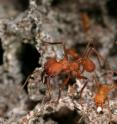Texas-bound: Fungus keeps Texas leaf-cutter ants from spreading
Texas winters may seem mild to those who move here from farther north, but they can be hard to adjust to for immigrants from warmer climates. This is true not only for people but for ants too. A new study by biologists at Rice University and the University of Texas at Austin (UT) finds that the Texas leaf-cutter ant Atta texana, whose ancestors emigrated from the tropics, adapted to the relatively harsh Texas winters in an unusual way -- through their food. Like all leaf-cutter ants, A. texana cuts leaves but does not eat them.
"Leaf-cutters can't digest the nutrients of leaves directly, so they use a fungus called Attamyces as a kind of external digestive system," said co-author Scott Solomon, a lecturer in ecology and evolutionary biology at Rice. "It's an example of a relationship that biologists call mutualism. The ants are completely reliant on the fungus, and the fungus -- which only occurs in leaf-cutter colonies -- is likewise reliant on the ants."
The new study, which appears this week in the Proceedings of the National Academy of Sciences, found that leaf-cutter colonies in northern Texas and Louisiana, where winter temperatures regularly get below freezing, have found new ways to cope with the cold. Most leaf-cutter ant species are native to the predictably warm tropics, so the Attamyces fungus has adapted to a narrow range of temperatures. Previous studies have found the ants are attentive gardeners; they keep an ever-present watch on their subterranean gardens, and they are careful to regulate humidity in the gardens and to weed out anything that threatens the crop.
Solomon began studying leaf-cutter ants as a graduate student in the UT-Austin laboratory of lead co-author Ulrich Mueller. Solomon continued investigating leaf-cutter ants and their close relatives while he was based in Brazil and Washington, D.C., during a postdoctoral fellowship from the National Science Foundation. Since joining Rice's faculty in 2009, he has continued his interest in leaf-cutter ants by investigating the Texas variety.
"A. texana provides a great subject for studying mutualism because it's isolated from closely related species, and it lives at the northern extreme of the leaf-cutters' range," Solomon said. "We wanted to find out how it could survive the winters here, and given that it can, we wanted to know why it hasn't expanded even farther north."
Leaf-cutters live in large colonies that contain up to 5 million members, and their subterranean nests have been found to extend almost 100 feet underground. Within these warrens, they dig thousands of tunnels that connect various chambers, where football-sized gardens of Attamyces are cultivated.
Over several years, Mueller's team systematically mapped the range of the ants and collected samples of live Attamyces fungus from dozens of nests throughout the range. Tests in the lab revealed that the Attamyces in more northerly ant colonies resists cold better than samples from southern nests, where winters are milder. The studies also found that the ants aid the cold-tolerant fungi by moving them during the coldest months of the Texas winter into deeper garden chambers where conditions are milder.
The researchers were able to show that the fungus's resistance to cold is based on genetic differences; this suggests that it has evolved during the several million years since the ants first arrived from the south with fungus in tow.
In addition to determining how leaf-cutter ants can survive outside the tropics, the study also found that the ants have been prevented from spreading farther north by the physical limitations of their fungal crop. According to Solomon, the finding that a species is limited by its mutualist is of particular interest to biologists.
"The range of the ants is not limited by their own tolerance to the cold but by the tolerance of the fungus," Solomon said. "The range of one species is often influenced by the range of another -- particularly harmful ones like predators or competitors -- but it is really rare to find a case where a species' range is completely dependent upon the evolution of a species that is helpful."
Source: Rice University
Articles on the same topic
- Texas leafcutter ants aided, but also limited, by cold-tolerant fungus crops, research showsTue, 22 Feb 2011, 16:33:48 UTC
Other sources
- Texas leafcutter ants aided, but also limited, by cold-tolerant fungus crops, research showsfrom Science DailyWed, 23 Feb 2011, 3:30:32 UTC
- Texas-bound: Fungus keeps Texas leaf-cutter ants from spreadingfrom PhysorgTue, 22 Feb 2011, 16:50:16 UTC
- Texas leafcutter ants aided, but also limited, by cold-tolerant fungus crops, research showsfrom Science BlogTue, 22 Feb 2011, 16:30:29 UTC
